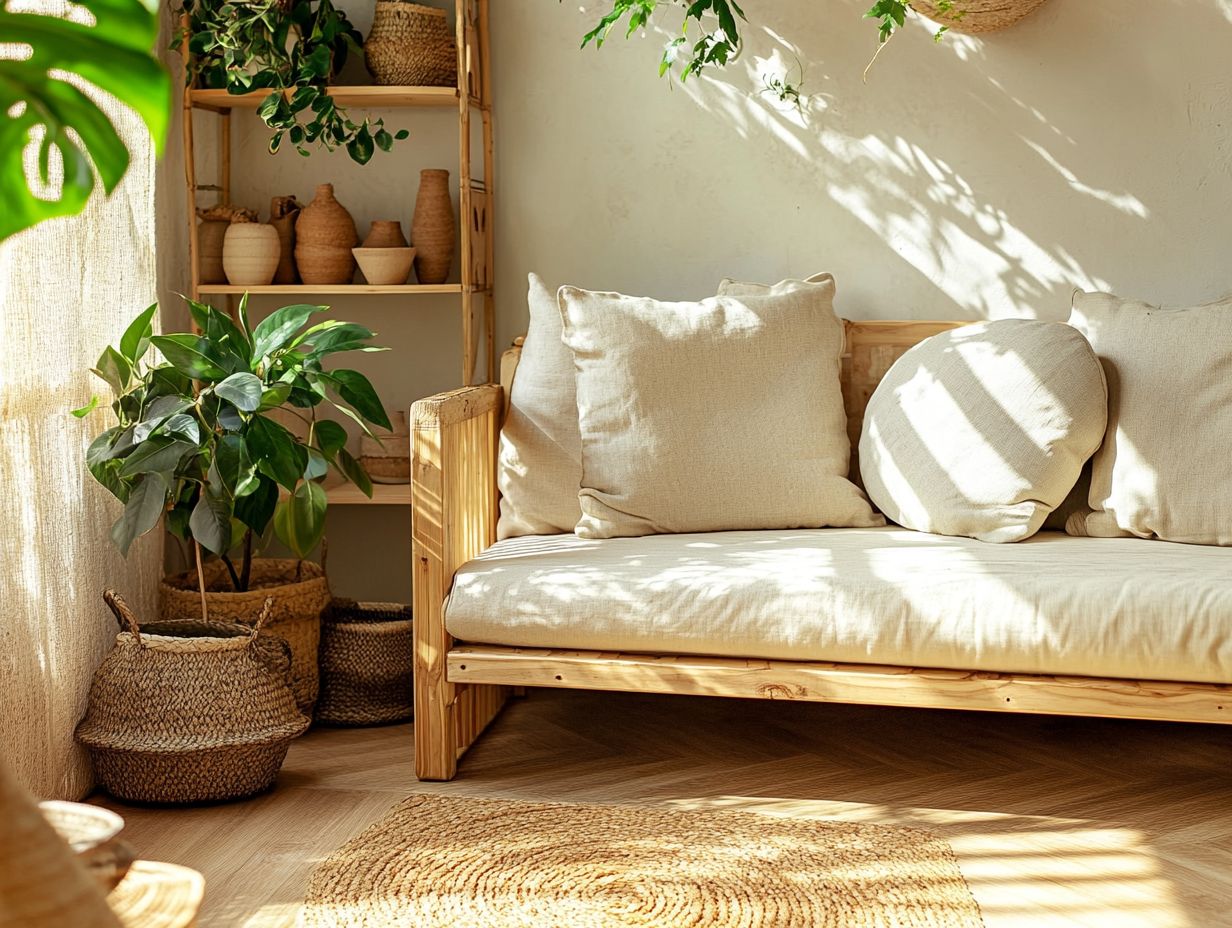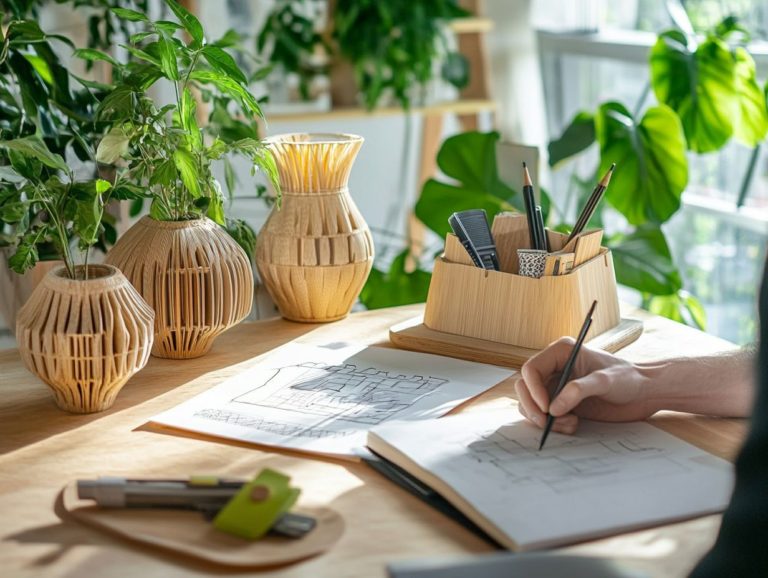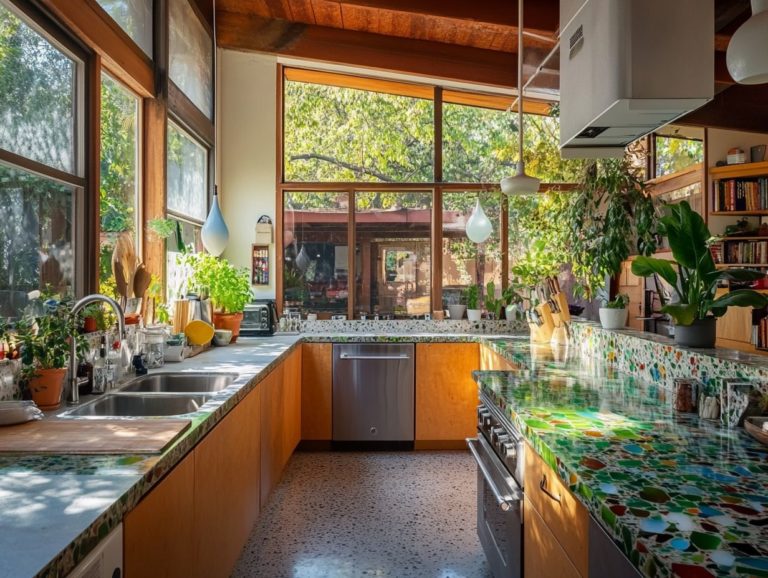How to Make Your Home More Sustainable with Materials
Are you striving to enhance your home s eco-friendliness while also trimming down costs? Sustainable materials present an ideal solution, merging environmental benefits with stylish durability.
Delve into the concept of sustainable materials, exploring their positive impact on the planet and how they can lead to significant savings over time.
You ll uncover some of the finest materials for home use, along with practical tips for seamlessly integrating them into your space to achieve long-lasting sustainability.
Immerse yourself in the journey toward creating a greener home!
Contents
- Key Takeaways:
- Benefits of Using Sustainable Materials in Your Home
- Top Sustainable Materials for Home Use
- How to Incorporate Sustainable Materials into Your Home
- Long-Term Sustainability in Your Home
- Frequently Asked Questions
- 1. What does it mean to make your home more sustainable with materials?
- 2. How can I make my home more sustainable with materials?
- 3. What are some examples of sustainable materials for my home?
- 4. Can I make my home more sustainable with materials without breaking the bank?
- 5. How will making my home more sustainable with materials benefit the environment?
- 6. Can I still have a stylish and comfortable home while making it more sustainable with materials?
Key Takeaways:

- Choose sustainable materials to cut your environmental impact and save money.
- Look into eco-friendly options like bamboo, cork, and reclaimed wood for a sustainable home.
- Consider durability and maintenance when incorporating sustainable materials into your projects.
What are Sustainable Materials?
Sustainable materials are products crafted with a keen awareness of their environmental impact, utilizing renewable energy sources and local resources to effectively reduce carbon footprints. They encompass a variety of options, from eco-friendly paints and sustainable flooring to recycled materials that help conserve precious natural resources.
By choosing these materials, you contribute to environmental protection and champion practices that ensure a sustainable future for generations to come. In essence, sustainable materials are essential for green homes and fostering an eco-friendly built environment.
Take bamboo, for instance. Its rapid growth and impressive strength make it an ideal choice for flooring and furniture. Then there’s cork, harvested from the bark of cork oak trees without causing harm, offering remarkable insulation and durability. Don t overlook cellulose, made from recycled paper products, which delivers exceptional thermal performance it helps keep your home warm in winter and cool in summer and is frequently used in insulation systems.
Integrating these materials into your building and renovation projects boosts both style and energy efficiency while promoting healthier living environments. Embracing such sustainable options aligns perfectly with the vital goal of preserving our planet s resources for future generations, creating a comprehensive approach to eco-friendly practices in everyday life.
Benefits of Using Sustainable Materials in Your Home
Using sustainable materials in your home brings numerous advantages beyond looks. You’ll discover that these choices cut down energy use and keep your home healthier by utilizing eco-friendly paints and energy-efficient appliances.
Sustainable materials enhance insulation and air sealing, leading to lower utility bills while significantly improving indoor air quality. Investing in these materials also helps conserve water with features such as low-flow toilets and efficient HVAC systems, ultimately crafting a healthier living environment while championing sustainable practices.
Environmental Impact
The environmental impact of using sustainable materials is remarkable. These products often rely on renewable energy sources and reduce energy consumption, effectively lessening the carbon footprint of your home.
By choosing eco-friendly paints and energy-efficient appliances, you can significantly cut harmful emissions and create a healthier living environment.
Engaging in sustainable practices like intelligent planting and sourcing local materials protects ecosystems and boosts biodiversity. This results in a lasting positive impact.
According to a report from the World Resources Institute, embracing sustainable materials can lead to a reduction in greenhouse gas emissions by as much as 30%. This holds especially true for bio-based materials, which sequester carbon and support soil conservation.
Sourcing materials locally reduces transportation emissions, supports local economies, and eases the pressure on global resources. Ultimately, these practices foster ecological balance and promote responsible consumption patterns.
By making informed choices, you play a pivotal role in advancing sustainability and combating climate change.
Cost Savings

Cost savings provide a strong reason to adopt sustainable solutions in your home building and renovation projects. Investing in energy-efficient appliances and renewable energy sources can lead to significant reductions in energy consumption and lower utility bills.
While the initial cost for sustainable materials may seem high, the long-term savings and increased value of your home often outweigh these expenses. Employing strategies like efficient HVAC systems and smart thermostats can enhance these savings even further!
You can find immediate financial relief through tax incentives and rebates when you integrate sustainable technologies into your projects. For instance, installing solar panels not only cuts your electricity costs but can also return your investment through various government programs.
While sustainable materials like bamboo flooring or recycled steel may involve a higher upfront cost, they promise durability and lower maintenance expenses over time.
These choices contribute to a lower ecological footprint and pave the way for a resilient financial future for your family, helping stabilize expenses despite the unpredictable nature of energy costs.
Top Sustainable Materials for Home Use
When considering the best sustainable materials for your home, several eco-friendly building options stand out due to their performance and environmental benefits. For a comprehensive understanding, check out sustainable materials: a guide for homeowners. Consider using materials like bamboo, cork, and sustainable flooring that minimize waste and enhance your space’s visual appeal.
- Bamboo: A fast-growing, renewable resource.
- Cork: Harvested from the bark of cork trees, it s biodegradable and offers excellent insulation.
- Recycled materials: Reduces waste and showcases your commitment to the environment.
These materials help create a sustainable home while offering durability, elegance, and health benefits. Integrating sustainable materials can further boost your design’s sustainability, highlighting your commitment to resource conservation.
Ready to make your home more sustainable? Start exploring why your home needs more sustainable materials today for a greener tomorrow!
Eco-Friendly Building Materials
Eco-friendly building materials, such as sustainable insulation and energy-efficient air systems, are essential for reducing your home’s carbon footprint while enhancing indoor air quality free from harmful chemicals often found in indoor air. These materials not only maintain comfortable living conditions but also contribute significantly to overall energy efficiency, making them perfect choices for homeowners who prioritize sustainability.
From energy-efficient lighting to sustainable flooring, the array of eco-friendly materials available can transform any space into a healthier and more sustainable environment.
Consider reclaimed wood it adds character to your interiors while simultaneously reducing the demand for new lumber, helping to preserve our precious forests. Innovations like bamboo, which grows quickly and absorbs carbon as it matures, are excellent options for flooring and cabinetry.
Low-flow plumbing fixtures fit seamlessly into modern designs and significantly cut down on water consumption.
With the introduction of solar panels, you can harness renewable energy directly. This leads to long-term savings and a diminished reliance on fossil fuels. By thoughtfully incorporating these materials, your residence can embrace eco-friendliness while exuding a sophisticated, modern elegance.
Recycled and Reclaimed Materials
Recycled and reclaimed materials are vital elements of sustainable solutions. They allow you to repurpose existing resources and minimize waste while supporting local economies. By incorporating materials like reclaimed wood or recycled metal, you can achieve a distinctive aesthetic that also makes a positive impact on the environment.
For instance, using reclaimed barn wood for furniture can infuse character and history into your living spaces. Meanwhile, recycled glass bottles can be transformed into stunning light fixtures or garden decor. The benefits go beyond mere aesthetics; these materials often require less energy to process, significantly lowering the carbon footprint associated with construction.
When you integrate these materials into your home projects, you can spark creativity and express your individuality, showcasing your personal style. Dive into creative DIY projects today! Build a patio with repurposed bricks or create a feature wall from salvaged tiles. Not only will you enhance your living environment, but you’ll also embrace an eco-friendly mindset that reflects your commitment to sustainability.
How to Incorporate Sustainable Materials into Your Home

Incorporating sustainable materials into your home requires a discerning approach. Emphasize the selection of energy-efficient appliances, sustainable flooring, and eco-friendly paints. Additionally, sourcing local sustainable materials for your home can enhance this thoughtful process, helping you create an environmentally friendly living space that reflects your values.
By choosing products that align with sustainable practices, you can significantly enhance your home’s energy efficiency and sustainability. Install smart thermostats and seal air leaks to boost energy performance. This results in a remarkable improvement in both comfort and utility costs.
Here are some eco-friendly materials to consider:
- Sustainable Insulation
- Energy-Efficient Air Systems
- Reclaimed Wood
- Bamboo Flooring
- Low-Flow Plumbing Fixtures
- Recycled Metal
- Recycled Glass
Start incorporating sustainable home materials into your home today to create a sustainable living environment!
Tips for Choosing and Using Sustainable Materials
Choosing sustainable materials requires thoughtful consideration. Focus on key factors like energy efficiency, durability, and environmental impact.
Look for materials that balance performance and sustainability. Also, consider local availability and costs to make the best choices.
Research product certifications like Energy Star or Greenguard. These labels show that products meet strict environmental standards.
Check the lifecycle impacts of products too. Understand how they are sourced, produced, and disposed of to see their true sustainability.
Look at performance metrics like warranty periods and user reviews. These insights highlight the reliability of the materials you choose.
By adopting these practices, you enhance your surroundings and commit to a healthier planet.
Long-Term Sustainability in Your Home
Long-term sustainability requires maintaining sustainable materials and using energy-efficient appliances. These efforts create a lasting positive impact on the environment.
Regularly examine the condition of your materials. This proactive approach extends the lifespan of eco-friendly products and saves you money.
Maintaining and Upgrading Sustainable Materials
Regular maintenance is essential to keep sustainable materials performing well. Check energy-efficient appliances and ensure proper air sealing.
Inspect insulation for moisture and check your eco-friendly roofing’s integrity. You can also upgrade by installing smart thermostats or advanced window treatments.
Familiarize yourself with sustainable product certifications like LEED or Energy Star. These can help you make informed choices and optimize energy savings.
Implementing these strategies lowers your utility bills and improves your home s environmental impact, benefiting both your household and the planet.
Frequently Asked Questions

1. What does it mean to make your home more sustainable with materials?
Making your home more sustainable means using eco-friendly and renewable resources for construction, furnishings, and decor. To get started, consider how to research sustainable materials for your home.
2. How can I make my home more sustainable with materials?
You can use recycled or natural materials, choose energy-efficient appliances, and apply green design principles.
3. What are some examples of sustainable materials for my home?
Examples include bamboo, reclaimed wood, recycled glass, and natural linoleum. Consider sustainable insulation like wool or recycled denim and low or no VOC paints.
4. Can I make my home more sustainable with materials without breaking the bank?
Absolutely! Try DIY projects with recycled materials, shop at thrift stores for furniture, and use local materials to cut costs.
5. How will making my home more sustainable with materials benefit the environment?
Using sustainable materials in your home cuts down the need for resources that can run out. This choice also helps reduce pollution and waste!
Sustainable materials usually have a smaller carbon footprint. This means they have a lower negative impact on our environment!
6. Can I still have a stylish and comfortable home while making it more sustainable with materials?
Absolutely! You can find many stylish and comfortable options in sustainable materials for your home.
Consider chic furniture made from reclaimed wood or cozy rugs made from natural fibers. You can create a beautiful and sustainable home that reflects your style!






